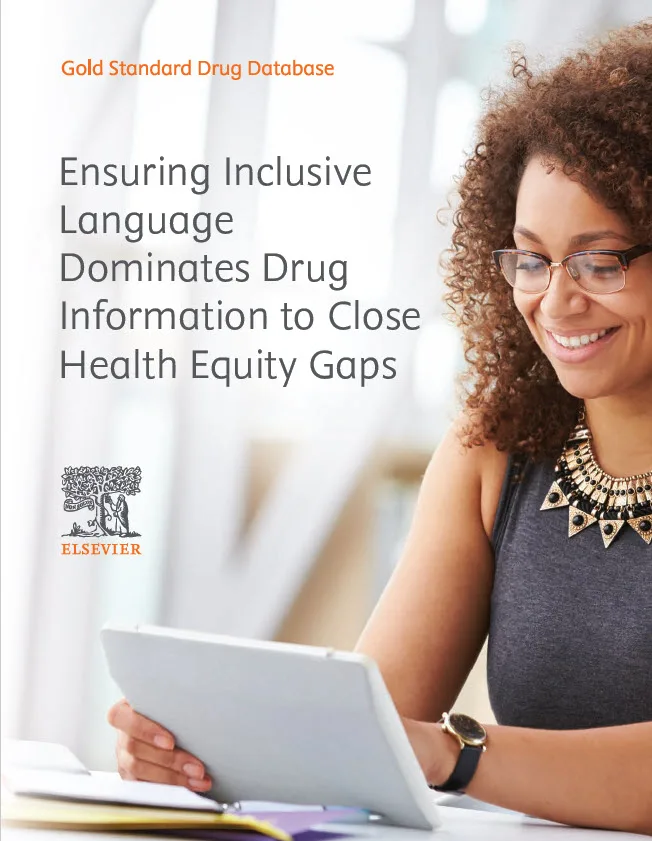We can help you get started with Gold Standard Drug Database

Votre navigateur n’est malheureusement pas entièrement pris en charge. Si vous avez la possibilité de le faire, veuillez passer à une version plus récente ou utiliser Mozilla Firefox, Microsoft Edge, Google Chrome, ou Safari 14 ou plus récent. Si vous n’y parvenez pas et que vous avez besoin d’aide, veuillez nous faire part de vos commentaires.
Nous vous serions reconnaissants de nous faire part de vos commentaires sur cette nouvelle expérience.Faites-nous part de votre opinion S’ouvre dans une nouvelle fenêtre


Ensuring Inclusive Language Dominates Drug Information to Close Health Equity Gaps
Download the Whitepaper S’ouvre dans une nouvelle fenêtreAs the healthcare system continues evolving, a greater emphasis is being place on health equity and social determinants of health (SDOH). Defined by the National Committee for Quality Assurance (NCQA) as everyone having “a fair and just opportunity to be as healthy as possible,” achieving health equity requires removing obstacles such as poverty and discrimination.
It also requires eliminating the consequences of these barriers, including powerlessness, lack of access to good jobs with fair pay, quality education and housing, safe environments, and healthcare.1
To that end, provider organizations, regulatory agencies, and close areas of weakness to achieve parity across race and ethnicity, gender, sexual orientation, socioeconomic status, and other factors. We see this in new and emerging care models that require providers to have a health equity plan and a data collection system that enables monitoring and incentivizes provider outreach to underserved communities.
Health plans and clinically integrated networks have also recognized the impact of health equity on health outcomes, resulting in initiatives and programs that meet their populations’ SDOH needs. For example, the Centers for Medicare and Medicaid Services (CMS) in 2022 released its Framework for Health Equity2 and proposed rule to advance health equity3, while NCQA introduced Health Equity Accreditation for health plans focused on the foundation of health equity work.
These developments are backed by a sound business case, as inequitable access to healthcare and unaddressed SDOH result in increased medical expenses, higher death rates, and uneven resource distribution.5 Consider that the elimination of health disparities — which contribute $93 billion in excess medical care costs — by 2050 would reduce the need for more than $150 billion in medical care. 6
What’s more, the U.S. Census projects that racial and ethnic minorities will constitute the majority of Americans by 20247, exacerbating the impact of racial disparities that currently cost the U.S. an estimated $135 billion in excess medical costs and lost productivity each year — as well as additional economic losses due to premature deaths.8 Behind insurance to higher prevalence of chronic conditions.
There is also a strong business imperative driving the push for health equity. In general, 65% of consumers say it is important that the companies they buy from actively promote diversity and inclusion.11 Within healthcare, payers are finding that mitigating inequities can increase Medicare Star ratings and drive business growth; one payer organization reported that 80% of the national account requests for proposals (RFPs) and 90% of Medicare RFPs it received in 2022 had at least one question on health equity.12
With so much on the line, it is easy to understand why health equity and SDOH have emerged as high priorities for providers — including pharmacy — and payers. One aspect that should not be overlooked in health equity strategies is the role language plays in creating barriers to care.
Language used by providers and payers in patient medication information and education materials is linked to a critical social determinant directly impacting care parity: education and health literacy. Limited health literacy, which impacts up to half of the U.S. population, affects a patient’s ability to get, process, and fully understand both health information and available health services when an informed medical decision needs to be made.13
As such, in the study published in the Journal of Health Care for the Poor and Underserved, the researchers concluded that working collaboratively on these three areas has “the potential to create a long-lasting impact in health care and medical education systems and to improve health equity for vulnerable linguistic minority communities well beyond the current pandemic.”14
Provider and payer associations and government agencies are responding to the realization of the role language plays in efforts to achieve health equity by issuing guidance and incentives to help their stakeholders understand and adopt inclusive terminology. For example, the American Medical Association (AMA) sought to help providers address language barriers with its Advancing Health Equity: A Guide to Language, Narrative and Concepts, providing guidance and promoting a deeper understanding of equity-focused, person-first language. It includes a section designed to help readers recognize the limitations and harmful consequences of some commonly used words and phrases and offers equity-centered alternatives15. NCQA, meanwhile, includes “access and availability of language services” and “cultural and linguistically appropriate services programs (CLAS)” in its Health Equity Accreditation for health plans.

In Health Equity Guiding Principles for Inclusive Communication, the Centers for Disease Control and Prevention (CDC) emphasizes the importance of addressing all people inclusively and respectfully. The principles published in the guidance are intended to help public health professionals ensure their communication products and strategies adapt to the specific cultural, linguistic, environmental, and historical situation of each population or audience of focus (16).
Finally, in a Harvard Business Review article focused on the role of inclusive language in equitable healthcare, Nkem Chukwumerije, MD, a national leader for equity, inclusion, and diversity at the Permanente Federation, offered six considerations for inclusive communications:
Consider the impacts of discrimination.
Address systemic health inequities.
Remember intersectionality.
Recognize diversity.
Promote health literacy.
Be mindful that context matters.
“As we understand and address the inequities, structural racism, and injustices experienced by marginalized populations we serve, health equity has become a watchword of modern health care,” writes Chukwumerije. “With that comes a commitment to providing equitable — as well as high-quality and accessible — health care, and a responsibility to choose our words carefully when communicating with our patients. In doing so, we take giant steps toward helping, rather than harming, them.” (17)
When it comes to acting on growing body of guidance around inclusive language, one area of significant impact is patient education. Specifically, it is important to provide equitable, appropriate, and effective health education to patients and health plan members throughout their healthcare journey. As such, when evaluating the health information being provided to patients and members, it is important ensure that education is delivered in their preferred language, and at a reading level for optimal understanding while still delivering important details (18).
It is helpful to follow the core tenets of inclusive, empowering, and person-centered language, as identified by the Linguistic Society of America. These are:
Foster inclusivity by acknowledging diversity, conveying respect to all people, being sensitive to differences, and promoting equal health outcomes. In healthcare, this includes being respectful to a range of beliefs and outcomes, for example by using the term “contraceptive” instead of “birth control.” It also means putting the person before the disease or condition and recognizing they are not defined by that disease or condition, such as stating “patient with diabetes” instead of “diabetic patient.” Finally, ensure language is inclusive of all genders, for example stating “it is a combination of estrogen and progestin” instead of “this medicine combines two types of female hormones.”
Increase understanding by being intentionally clear and concise and using common words to increase readability and understanding. This includes translating content so it can reach and embrace diverse customers, promote health literacy, and meet evolving regulatory requirements. Content should be developed and tested with the Flesch-Kincaid readability test, which emphasizes syllable count and the number of words per sentence. This may require some tradeoffs, however. For example, calling out the name of a condition, drug, or disease may decrease the readability score but is clearer than saying “it” or “this”.
Prompt action by enabling individuals to increase confidence, engage in discussions with care teams, and advocate for better health. For example, grouping symptoms and individually, listing side effects for a particular disease or condition, and/or providing suggestions for next steps based on symptoms will help the consumer determine urgency (e.g., differentiate side effects that a consumer should report to their care team as soon as possible from those that usually do not require medical attention.)
Person-centered medication education should address the following questions with inclusive and empowering language:
What is this medicine?
What should I tell my healthcare provider before I take this medicine?
How should I use this medicine?
What if I miss a dose?
What may interact with this medicine?
What side effects may I notice from receiving this medicine?
What should I watch for while taking this medicine?
Where should I keep my medicine?
Elsevier is one company that has embraced the important role language plays in patient education. As such, person-centered language is central to its consumer drug information, which has been updated to address consumers’ desire to have everywhere access to information, empower personal autonomy, find trusted information through quality content, and align values with actions, diversity, and inclusion.
For example, in the updated drug information, a patient who is taking Nicotrol® to help them quit smoking can read a description of the medication that includes information around how nicotine helps them quit as well as information around nicotine cravings. Personal autonomy is also highlighted by noting that using Nicotrol® in combination with a stop smoking program is more effective than either alone.
A female patient with a history of stroke and atrial fibrillation who is taking amiodarone and apixaban may be prescribed ketoconazole to treat a fungal infection, which creates a contraindicated drug interaction. Elsevier’s person-first drug information is now written to recognize personal autonomy, enabling the consumer to decide the next step, including when to call their care team and suggests care team engagement in case changes are required to minimize risk of side effects.
Finally, for a sexually active patient taking Descovy® to lower the risk of getting HIV through sex, Elsevier’s drug information now features a medication description that includes information around HIV and AIDs as well as other sexually transmitted infections. It also includes concise words and common acronyms like PrEP to increase her understanding (19).
As providers, payers and regulatory agencies seek ways to achieve care parity across race and ethnicity, gender, sexual orientation, socioeconomic status, and other factors, the use of inclusive and empowering language must be a priority for all patient/member communications. Inclusive, person-centered communications ensure patients and members understand and can appropriately act upon the information being conveyed, allowing them to play a proactive role in their healthcare and work together with providers and payers to make informed care decisions.

1 Social Determinants of Health 2 RESOURCE GUIDE | Social Determinants of Health Content Reproduced from HEDIS ®1 Volume 2: Technical Specifications for Health Plans by the National Committee. https://www.ncqa.org/wp-content/uploads/2020/10/20201009_SDOH-Resource_Guide.pdf S’ouvre dans une nouvelle fenêtre
2 CMS Framework for Health Equity | CMS. www.cms.gov. https://www.cms.gov/about-cms/agency-information/omh/health-equity-programs/cms-framework-for-health-equity S’ouvre dans une nouvelle fenêtre
3 CMS Proposes Policies to Advance Health Equity and Maternal Health, Support Hospitals | CMS. www.cms.gov. https://www.cms.gov/newsroom/press-releases/cms-proposes-policies-advance-health-equity-and-maternal-health-support-hospitals S’ouvre dans une nouvelle fenêtre
4 How Is Health Equity Important to Your Organization? NCQA. https://www.ncqa.org/programs/health-equity-accreditation/get-started/ S’ouvre dans une nouvelle fenêtre
5 Health Equity Resource Center. NCQA. https://www.ncqa.org/health-equity/ S’ouvre dans une nouvelle fenêtre
6 Turner A. The Business Case for Racial Equity. W.K. Kellogg Foundation; 2016. https://tinyurl.com/yb8zwvp8 S’ouvre dans une nouvelle fenêtre
7 US Census Bureau. Projections of the Size and Composition of the U.S: 2014-2060. Census.gov. Published March 3, 2015. https://www.census.gov/library/publications/2015/demo/p25-1143.html S’ouvre dans une nouvelle fenêtre
8 W.K. Kellogg Foundation
9 CDC. FastStats - Health of Black or African American Population. Published 2019. https://www.cdc.gov/nchs/fastats/black-health.htm S’ouvre dans une nouvelle fenêtre
10 Infographics - Health, United States - Products. Published 2020. https://www.cdc. gov/nchs/hus/spotlight/2019-heart-disease-disparities.htm S’ouvre dans une nouvelle fenêtre
11 Poole D. The power of inclusion and diversity in advertising. Kantar Marketplace. Published April 20, 2021. https://tinyurl.com/3a9tuex5 S’ouvre dans une nouvelle fenêtre
12 Webinar. Health Equity: The Meaning and Implications for Action within the Payer Industry. Fierce Healthcare. Held on December 1, 2022. https://tinyurl.com/bzbpttv8 S’ouvre dans une nouvelle fenêtre
13 Language & Social Determinants of Health: Impact on Health Equity. Globo. Published February 17, 2022. https://tinyurl.com/2k4v3p62 S’ouvre dans une nouvelle fenêtre
14 Ortega P, Martínez G, Diamond L. Language and Health Equity during COVID-19: Lessons and Opportunities. Journal of Health Care for the Poor and Underserved. 2020;31(4):1530-1535. doi:10.1353/hpu.2020.0114 S’ouvre dans une nouvelle fenêtre
15 Advancing Health Equity: A Guide to Language, Narrative and Concepts. American Medical Association. https://www.ama-assn.org/about/ama-center-health-equity/advancing-health-equity-guide-language-narrative-and-concepts-0 S’ouvre dans une nouvelle fenêtre
16 CDC. CDC’s Health Equity Guiding Principles for Inclusive Communication. Centers for Disease Control and Prevention. Published August 24, 2021. https://www.cdc.gov/health-communication/php/toolkit/ S’ouvre dans une nouvelle fenêtre
17 Chukwumerije N. Equitable Health Care Requires Inclusive Language. Harvard Business Review. Published July 19, 2022. https://hbr.org/2022/07/equitable-health-care-requires-inclusive-language S’ouvre dans une nouvelle fenêtre
18 Webinar
19 Elsevier Drug Information Presentation